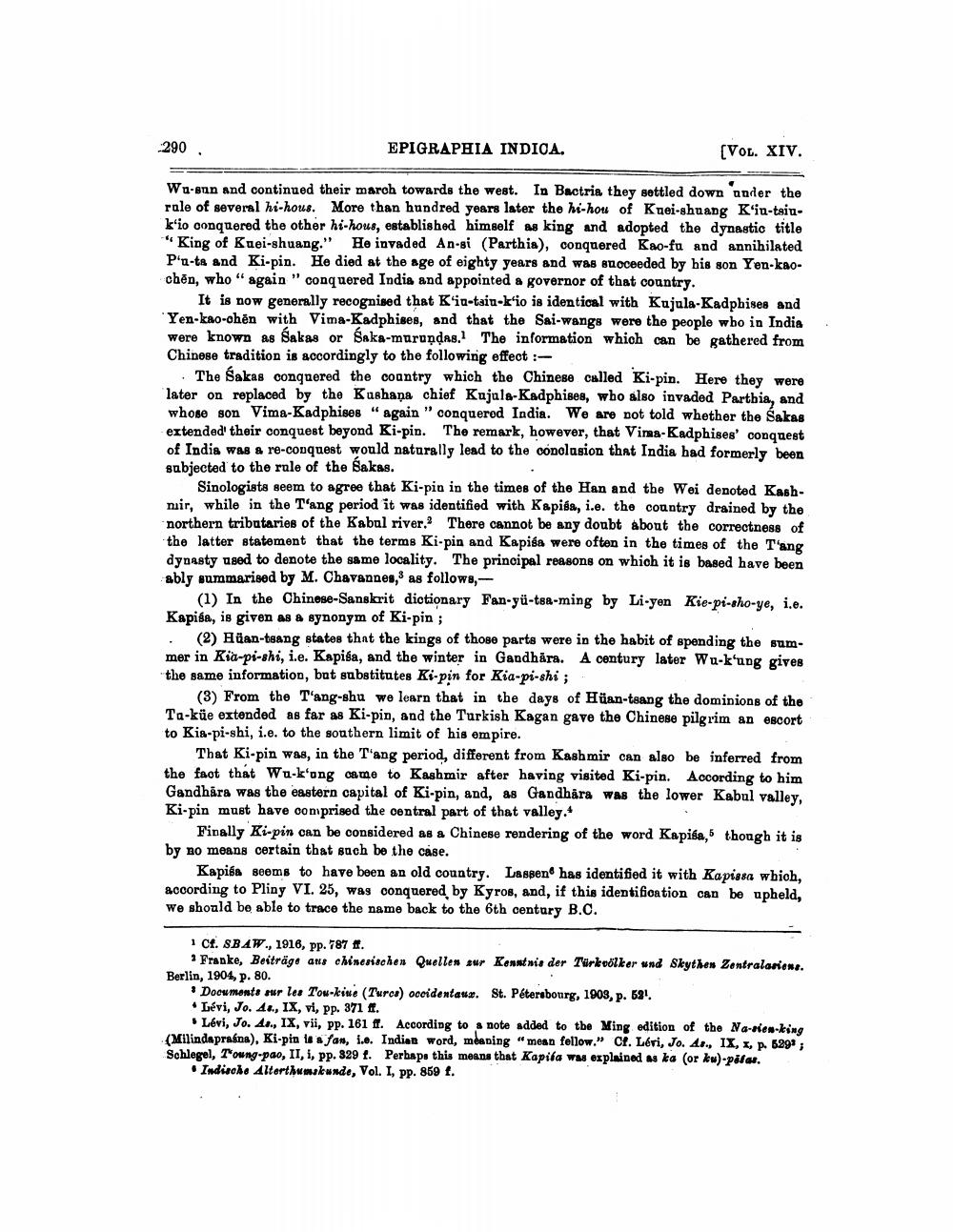________________
290.
EPIGRAPHIA INDICA.
(VOL. XIV.
Wa-sun and continued their march towards the west. In Bactria they settled down under the role of several hi-hous. More than hundred years later the hi-hou of Kuei-shuang K'in-tsiuk'io conquered the other hi-hous, established himself as king and adopted the dynastic title "King of Kuei-shuang." He invaded An-si (Parthia), conquered Kao-fu and annihilated Piu-ts and Ki-pin. He died at the age of eighty years and was suoceeded by his son Yen-kaochen, who "again" conquered India and appointed a governor of that country.
It is now generally recognised that K'i-tait-k'io is identical with Kujula-Kadphises and Yen-kao-chen with Vima-Kadphises, and that the Sai-wangs were the people who in India were known as Sakas or Saka-murundas. The information which can be gathered from Chinese tradition is accordingly to the following effect :
The Sakas conquered the country which the Chinese called Ki-pin. Here they were later on replaced by the Kushana chief Kujala-Kadphises, who also invaded Parthia, and whose son Vima-Kadphises “ again " conquered India. We are not told whether the Šakas extended their conquest beyond Ki-pin. The remark, however, that Vima-Kadphises' conquest of India was a re-conquest would naturally lead to the conolusion that India had formerly been subjected to the role of the Sakas.
Sinologists seem to agree that Ki-pin in the times of the Han and the Wei denoted Kashnuir, while in the T'ang period it was identified with Kapiga, i.e. the country drained by the northern tributaries of the Kabul river. There cannot be any doubt about the correctness of the latter statement that the terms Ki-pin and Kapisa were often in the times of the Tang dynasty used to denote the same locality. The principal reasons on which it is based have been ably summarised by M. Chavannes, as follows, -
(1) In the Chinese-Sanskrit dictionary Fan-yü-tea-ming by Li-yen Kie-pi-sho-ye, i.e. Kapisa, is given as a synonym of Ki-pin; . (2) Hüan-teang states that the kings of those parts were in the habit of spending the summer in Kia-pi-shi, i.e. Kapiga, and the winter in Gandhåra. A century later Wu-kung gives the same information, but substitutes Ki-pin for Kia-pi-shi;
(3) From the T'ang-shu we learn that in the days of Hüan-tsang the dominions of the Ta-küe extended as far as Ki-pin, and the Turkish Kagan gave the Chinese pilgrim an escort to Kia-pi-shi, i.e. to the southern limit of his empire.
That Ki-pin was, in the Tang period, different from Kashmir can also be inferred from the fact that Wu-kfong came to Kashmir after having visited Ki-pin. According to him Gandhára was the eastern capital of Ki-pin, and, as Gandhara was the lower Kabul valley, Ki-pin must have comprised the central part of that valley.
Finally Ki-pin oan be considered as a Chinese rendering of the word Kapita, though it is by no means certain that such be the case.
Kapiga seems to have been an old country. Lassen has identified it with Kapissa which, according to Pliny VI. 25, was conquered by Kyros, and, if this identification can be upheld, We should be able to trace the name back to the 6th century B.C.
1 Cf. SBAW., 1916, pp. 787 f.
Franke, Beiträge aus chinesischen Quellen zur Kenntnis der Türkvölker und Skythen Zentralasiens. Berlin, 1904, p. 80.
Doonmonts sur les Tow-kine (Turcs) cocidentaux. St. Petersbourg, 1903, p. 591. . Lévi, Jo. 41., IX, vi, pp. 371 ff.
Lévi, Jo. A.., IX, vii, pp. 161 ff. According to a note added to the Ming edition of the Nawiew-king (Milindapraśna), Ki-pin is a fan, i.e. Indian word, meaning "mean fellow." CH. Léri, Jo. 41., IX, X, p. 629; Schlegel, Toung pao, II, 1, pp. 329 t. Perhaps this means that Kapila was explained as ka or kw)-pilar.
Indische Alterthuwakunde, Vol. I, pp. 859 f.




